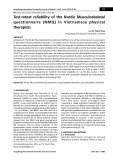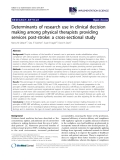
Test-retest reliability of the Nordic Musculoskeletal questionnaire (NMQ) in Vietnamese physical therapistsLe Thi Thach ThaoHong Bang International University, VietnamABSTRACTBackground: The Nordic Musculoskeletal Questionnaire (NMQ) is one of the screening tools to assess pain or discomfort of musculoskeletal disorders. It is widely used in various occupational populations. Many previous studies investigated the reliability of the NMQ, but there are no evidences in Vietnam. Objective: This study evaluated the test-retest reliability of the question about trouble with the locomotive organs in the NMQ in Vietnamese physical therapists (VPTs). Materials and method: It was a cross-sectional study in 10 VPTs by a convenient sampling technique. An online questionnaire was distributed to all participants twice times with a 7-day interval. They reported their musculoskeletal disorders during the last 12 months and the last 7 days and been prevented from doing normal work because of their troubles. The test-retest reliability of dichotomous data produced by the NMQ was accessed by using the kappa coefficient (k) and the level of significance was set at a p-value of less than 0.05. Results: Among 27 binary choice items, there were 5 items where k could not be computed as response were 100% negative on both testing occasions. Eight items showed not significant correlation poor to moderate agreement (k ≤ 0.40, p-value > 0.05). Fourteen items showed substantial to excellent test-retest reliability (k = 0.74-1.00, p-value < 0.05). Conclusion: The results suggest that the NMQ can be used with acceptable reliability for evaluating the musculoskeletal disorders and labour risks among VPTs.Keywords: Nordic Musculoskeletal Questionnaire, musculoskeletal disorders, pain, discomfort, reliabilityNearly four decades ago, Kourinka et al. [1] developed the Nodic Musculoskeletal Ques-onnaire (NMQ) to assess the musculoskeletal symptoms in ergonomic context and occupaonal health. It was used widely as an indirect tool to idenfy the musculoskeletal problems in different occupaonal groups including physical therapists [2 - 5]. In Vietnam, the NMQ was also used as a screening tool to detect musculoskeletal disorders in different sample populaons such as nurses or healthcare workers [6, 7]. Many previous studies showed that the NMQ had good psychometric properes to determine musculoskeletal disorders [8]. However, the tes-retest reliability of the quesonnaire about trouble with the locomove organs in the NMQ is unknown in Vietnam. To make this quesonnaire commonly used in Vietnam, one study should be done. Therefore, the purpose of this study was to evaluate the test-retest reliability of the NMQ in VPTs. The reliability of a ques-onnaire was considered as the consistency of the survey results by using its test-retest reliability in this study. Test-retest reliability is the degree to which test scores remain unchanged when measuring a stable individual characterisc from the same person on different occasions [9]. In this study, the evaluaon of test-retest reliability of the self-reported quesonnaire was conducted on two occasions. There is no evidence available to select the me interval between quesonnaire administraons at occasion 1 and occasion 2. Authors recommended that a retest interval of one or two weeks is commonly used for the evaluaon of test-retest reliability, so a 7-day interval was used in the present study [9 - 10]. 2. MATERIALS AND METHOD2.1. ParcipantsPotenal parcipants included all licensed Vietnamese physical therapists (VPTs) at least 22 81Hong Bang Internaonal University Journal of ScienceISSN: 2615 - 9686Hong Bang Internaonal University Journal of Science - Vol.4 - June 2023: 81-86DOI: hps://doi.org/10.59294/HIUJS.VOL.4.2023.389Corresponding Author: MSc. Le Thi Thach Thao Email: thaoltt2@hiu.vn1. BACKGROUND

























